
Stocks in developed markets showed they can stand up to a lot last week. One thing they almost certainly can’t withstand is a global recession.
With oil again surging as governments step up sanctions on Russia, yield curves signaling growing apprehension over growth and concerns mounting about 2008-style liquidity crunches as the dollar surges, pressure on economies is rising. Should it result in a full-blown downturn, it will become much harder for equities to stay resilient.
U.S. stock futures plunged as much as 2.9% Monday, erasing gains from late last week as speculation that central banks would throttle back on tightening policy gave way to worry that the geopolitical crisis in Europe could slow global economic growth. Getting that call right can be the difference between a 36% drop — the average bear-market decline — in the S&P 500 or a more pedestrian downturn in stocks that could give way to a rebound, said JC O’Hara, chief market technician at MKM Partners.
MKM noted 33 corrections in the S&P 500, defined as 10% declines from closing highs. Seven of those extended losses to meet the accepted definition of a bear market, down 20% — but the other 26 reversed and led to new highs. The average correction was 15% — in line with the 14.6% drop from Jan. 4 to the intraday low on Feb. 24.
For MKM, if the economy is not set to enter a recession, then the market’s lows should more or less be in. “If we are not entering an economic recession, we should use the playbook of a correction inside a structured bull market,” O’Hara said.
Signs abound that the ride may not be so easy this time. Oil prices, the yield curve and the Fed’s expected policy tightening are among indications that the U.S. and global economies may be strained in unusual ways as policy makers navigate the continued pandemic, inflation and now geopolitical tensions that may be the highest since World War II.
China, seen as a bastion of strength by some, has its own weak points: a highly indebted property market, various industry crackdowns, and uncertainty over strict policies to try to keep Covid cases near zero.
Stifel equity strategist Barry Bannister said there have been 17 non-recession S&P 500 corrections greater than 10% since 1962, with an average drop of 16.95% — so he now sees a floor for the gauge at 4,050, or a drop of about 15% from the early-January record close.
He expects slower economic growth in China, which lowers global and U.S. manufacturing gauges, and sees further downside for M2 money supply tightening financial conditions and lowering “overextended” S&P 500 valuations. That’s in addition to longer-tailed issues surrounding Russia-Ukraine, he said.
“A recession is likely to start at some point this year,” said Matt Maley, chief market strategist at Miller Tabak + Co. “We’re headed for a bear market.”
Read more at:
Economictimes Indiatimes.com
